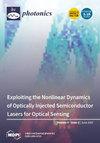用于成像的 NaYF4:Yb,Er 上转换纳米粒子:对红细胞的影响
IF 1.9
4区 物理与天体物理
Q2 OPTICS
引用次数: 0
摘要
(1) 背景:上转换纳米粒子(UCNPs)是一种用于生物组织结构可视化和光动力疗法(PDT)的前景广阔的工具。这类 NPs 在光谱的近红外(NIR)区域发光,而 NPs 则在可见光区域发光。将这种 NPs 与吸收其发光的光动力染料共轭,可增加进行光动力疗法的深度。(2)方法:我们对将 NaYF4:Er:Yb UCNPs 用于体内成像和 PDT 的可能性进行了全面研究。NPs 是通过水热法合成的。结果表明,合成的 NPs 尺寸为 80 nm,呈六角形结构。(3) 结果:研究了大鼠静脉注射 NPs 后在器官中的蓄积情况。还研究了 NPs 对红细胞(RBC)形状、大小和聚集程度的影响。(4) 结论:实验证明了 NPs 在组织切片中的发光可视性及其皮下分布。所有研究的颗粒都显示出中等毒性,引起的变化大多是可逆的。本文章由计算机程序翻译,如有差异,请以英文原文为准。
NaYF4: Yb,Er Upconversion Nanoparticles for Imaging: Effect on Red Blood Cells
(1) Background: Upconversion nanoparticles (UCNPs) are a promising tool for biological tissue structure visualization and photodynamic therapy (PDT). The luminescence of such NPs is excited in the spectrum’s near-infrared (NIR) region, while the NPs luminesce in the visible region. Conjugating such NPs with photodynamic dyes that absorb their luminescence makes it possible to increase the depth at which PDT is performed. (2) Methods: We conducted a comprehensive study on the possibility of using NaYF4:Er:Yb UCNPs in vivo for imaging and PDT. The NPs were synthesized by a hydrothermal method. The synthesis of NPs with a size of 80 nm and hexagonal structure was demonstrated. (3) Results: The accumulation of NPs in organs after their intravenous injection into rats was studied. The effect of NPs on the shape, size, and degree of aggregation of red blood cells (RBC) was also investigated. (4) Conclusions: The possibility of luminescent visualization of NPs in histological sections and their subcutaneous distribution is demonstrated. All investigated particles showed moderate toxicity, causing mostly reversible changes.
求助全文
通过发布文献求助,成功后即可免费获取论文全文。
去求助
来源期刊

Photonics
Physics and Astronomy-Instrumentation
CiteScore
2.60
自引率
20.80%
发文量
817
审稿时长
8 weeks
期刊介绍:
Photonics (ISSN 2304-6732) aims at a fast turn around time for peer-reviewing manuscripts and producing accepted articles. The online-only and open access nature of the journal will allow for a speedy and wide circulation of your research as well as review articles. We aim at establishing Photonics as a leading venue for publishing high impact fundamental research but also applications of optics and photonics. The journal particularly welcomes both theoretical (simulation) and experimental research. Our aim is to encourage scientists to publish their experimental and theoretical results in as much detail as possible. There is no restriction on the length of the papers. The full experimental details must be provided so that the results can be reproduced. Electronic files and software regarding the full details of the calculation and experimental procedure, if unable to be published in a normal way, can be deposited as supplementary material.
 求助内容:
求助内容: 应助结果提醒方式:
应助结果提醒方式:


